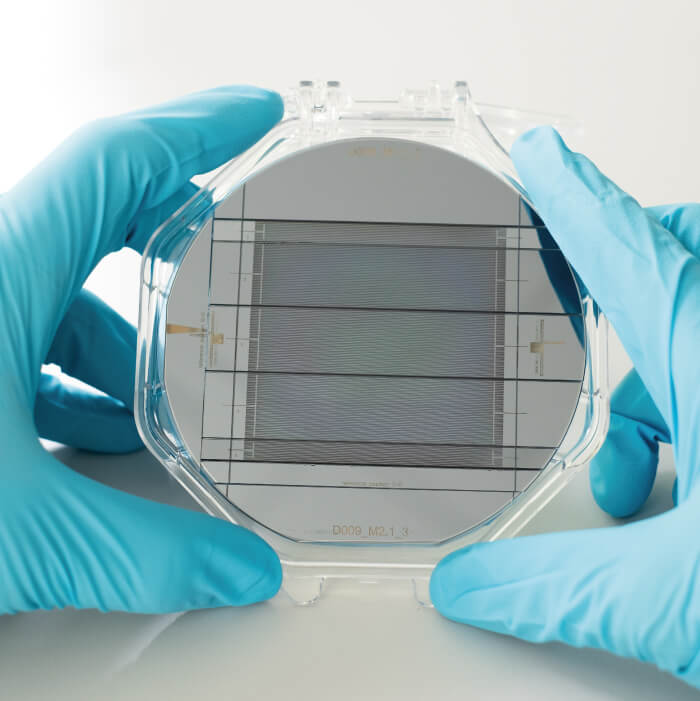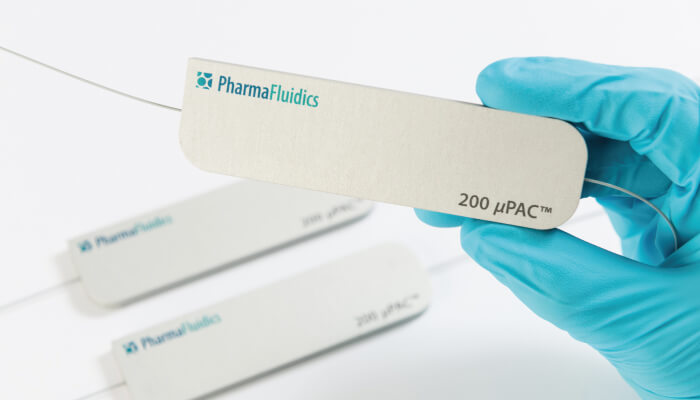PharmaFluidics was formed as a spin-out at Vrije Universiteit Brussel in late 2010 and set up shop as a microfluidics consulting boutique. Since 2014, we’ve focused exclusively on microfluidic devices for chromatography. In late 2017, we launched our flagship product – the μPAC nano-LC column – onto the market, which immediately attracted a lot of interest, including an innovation award from The Analytical Scientist! In brief, the μPAC is a microfluidic chromatography column with its pillar array stationary phase backbone etched out of silicon wafer; this technology provides exceptional resolution, sensitivity, robustness, reproducibility and retention time stability. Following feedback from our users, we added the μPAC trapping column to our portfolio in 2019.
Having decrypted the genetic heritage of numerous species (including humans), biologists now want to characterize the totality of the proteins in an organism or even a single cell. Technically, this is extremely difficult because of the proteome’s complexity and highly dynamic concentration range – and the absence of amplification techniques comparable to PCR; it is not surprising that researchers in this field welcome new technology that can make the task a little easier. The uniform pillar arrays of the μPAC allow for the longer gradient separations needed for complex biological samples, for example by eliminating the need for prefractionation (read more about proteomic analyses with μPAC at tas.txp.to/perfecting.)
The company is steadily expanding as μPAC moves into more labs. It’s been great to hear from our customers about the difference it is making to their research and to feel that we have played a part in some truly groundbreaking advances (see “μPAC at the Edge”).
We have expanded our operations, and we will commission a second dedicated assembly and QC line at our Ghent facility.
A special highlight of 2019 so far has been receiving the European Proteomics Association (EUPA) Award. We are very grateful to EUPA and the proteomics community for recognizing the contribution of μPAC to improving and standardizing nano-LC/MS proteomics workflows. It is an achievement that belongs primarily to our pioneer users and product champions, who are setting new standards, breaking records and advancing the field of proteomics.
Tree of Life
At the EMBL Wellcome Genome Campus Conference in March 2019, the Matthias Mann Group (Max Planck Institute, Munich, Germany) presented the quantitative proteome atlas of 100 organisms across all three kingdoms, fingerprinted thanks to the high retention time stability and reproducibility of the μPAC. The Tree of Life is the largest open access proteome data set ever reported, with more than 250,000 proteins.
Labs around the world can use the open access database together with μPAC and machine learning to predict a retention time fingerprint for each individual protein in the Tree of Life – the potential for hyper-resolved target data deconvolution is immense.
Doubling Up on Single Cells
Single-cell proteomics is poised to revolutionize many fields of biological research, with important implications for therapeutics, discovery, genomics and translational research. In a presentation titled “Double protein IDs in Single Cell protocols”, Karl Mechtler (Institute of Molecular Pathology, Vienna) explained how his group have identified 3,500 proteins in a 10 ng HeLa cell sample using the μPAC LUMOS workflow at EUPA Potsdam in March 2019.
Deep-dive DIA
Also at EUPA Potsdam, Lukas Reiter (BIOGNOSYS, Schlieren CH) presented results from 9,000 quantified HeLa proteins, covering five orders of magnitude in a μPAC–HFX–DIA workflow. Single-shot quantitative deep-dive μPACTMDIA proteomics has great potential for pathway elucidation and endpoint design during clinical trials, and later in body fluid multiplex/panel proteome diagnostics.

Looking to the future, we are focused on two main growth areas: deepening our reach in the proteomics space and broadening access technology in other chromatography segments by accommodating higher-flow-rate regimes.
The company has become well known as a solution provider for deep-dive proteomics, where sensitivity is paramount. As proteomics moves closer to the clinic, other benefits of μPAC – namely, retention time stability and reproducibility – have started to attract more attention. For longitudinal, large-cohort or multiple-site studies, the robustness and reproducibility of all steps in the HPLC-MS-proteomics workflow are of paramount importance, as this is critical to build large data pools with maximum statistical power and minimal noise and bias. Many of the greatest workflow challenges for large-cohort (clinical, diagnostic) proteomics relate to lab-to-lab reproducibility, method standardization, and scalability – all areas where μPAC has a real edge.
Currently, μPAC is mostly used in nanoflow regimes, so the second focus is to move into areas that are using higher-flow-rate regimes, such as routine biopharma applications. Building on the design and engineering of the popular μPAC trapping columns we launched earlier this year, we will introduce our Capillary LC μPAC Column at ASMS 2019, and start taking pre-orders for deliveries in September.
Early on, it was clear that high-end proteomics was the most suitable entry point into the analytical HPLC market, compatible with PharmaFluidics’ capabilities and limitations. Having a clear focus on one high-end, niche market proved to be the right thing to do, allowing PharmaFluidics to get a place on the scene and to grow at a manageable rate. Now that we have further developed our manufacturing and supply chain resources, we are ready to take on broader market segments.
Our customers are now spread over a much wider area, which makes our operations more complex. Although it makes for long days, it’s a nice problem to have!






